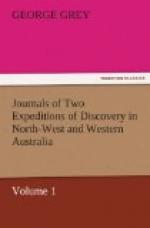The Glenelg River, in like manner, is subject to sweeping inundations, rising sometimes to the height of fourteen to fifteen feet above its usual level, as was evinced by the weeds and other substances we saw in the trees on its banks.
To show that these are characteristics of the Fitzroy River I shall quote the authority of Captain Wickham from a letter addressed to me just before our meeting at Hanover Bay:
It (the Fitzroy) appears to be very similar to the rivers on the south-east side of New Holland, subject to dreadful inundations, caused by heavy floods in the interior, and in no way connected with the rainy season on the coast. Our visit to it being in February and March, immediately after the rainy season on the coast, without our seeing any indication of a recent flooding, although there were large trunks of trees and quantities of grass and weeds lying on the bank and suspended from the branches of trees from ten to twelve feet above the level of the river. The bed is entirely of sand.
...
INUNDATIONS.
It will be clearly seen how nearly this corresponds with what we observed about the same season on the banks of the Glenelg. I have therefore little doubt that the Fitzroy takes its origin from the same mountain chain, and that the inundations described by Captain Wickham originate in the causes which I have here assigned.
To demonstrate more clearly the similarity of character of these rivers with those of New South Wales I shall quote two passages from the British Colonies of Mr. Montgomery Martin, regarding the Hawkesbury and Hunter Rivers of that colony:
The Hawkesbury, which is a continuation of the Nepean River, after the junction of the latter with a considerable stream, called the Grose, issues from a remarkable cleft in the Blue Mountains in the vicinity of the beautiful town of Richmond, about forty miles from Sydney. Along the base of these mountains the Hawkesbury flows in a northerly direction, fed by numerous tributary mountain torrents, descending from narrow gorges, which, after heavy rains, cause the Hawkesbury to rise and overflow its banks as it approaches the sea. In one instance it rose near the town of Windsor ninety-seven feet above its ordinary level. Volume 4 page 257.
Again he says, page 258:
Hunter’s River, about seventy miles to the northward of Port Jackson, disembogues into the sea at the harbour of Newcastle.
There are three branches to the Hunter, called the upper, the lower, and the middle: the two former are navigable for boats for about 120 miles, and the latter for about 200 miles; but the branches are all subject to sudden and terrific inundations owing to the rapid descent of torrents from the Blue Mountains.
...
MOUTH OF THE GLENELG.




